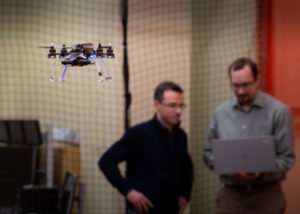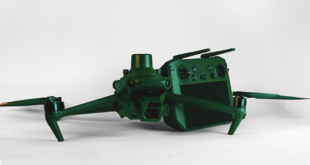MA-based engineering firm Draper and DoD are working together on the next generation of small drones – developing technology to improve autonomous navigation that could rapidly move into the commercial space.
Under a three-year contract with the Department of Defense, Draper is focused on addressing the hardest parts of autonomous navigation – demonstrating how they can equip small drones to reduce collisions and develop robust new navigation methods.
“The goal is to provide soldiers with an unmanned system that can fit in a backpack and serve as eyes and ears in areas too dangerous for troops to physically enter, such as suspicious buildings or a turn in the road ahead,” says a Draper press release. “Delivering such capability requires an autonomy architecture and software package that can enable UAVs to do more than ever before.”
Autonomy is a key capability for commercial drones as well as military drones. Ease of use – allowing small drones to avoid obstacles more easily – means that drones can be more widely used in the commercial arena, and can be used for inspection or monitoring of any complex environment: whether that’s an urban interior or the underside of a bridge.
Draper and the DoD are working together on a system that could be applied to any small UAV airframe. “The system is platform-agnostic and ready for integration into micro-, mini- and small-UAVs and autonomous land systems,” says the Draper release.
“Draper’s engineers demonstrated their software on a small UAV chosen by the customer to navigate narrow interiors in simulated urban environments, create 3D maps of their interior, identify and avoid objects and return autonomously to the base,” says the Draper release. “Unmanned systems equipped with Draper’s autonomy architecture and software package need no remote pilot, no GPS guidance, no communications link for navigation and no pre-programmed map of the area—the onboard software, lightweight processor and low-cost sensors do all the work autonomously in real-time.”
“The new generation of small UAVs need to be able to fly independently and plan an obstacle-free route in real-time without any prior knowledge of the environment,” said Jon Cash at Draper. “The goal is closed-loop and fully autonomous flight, but until now that goal has been out of reach for the UAV community at large.” Cash leads a team that builds on Draper’s six decades of experience in unmanned and robotic systems for air, land and sea.
Gian Luca Mariottini at Draper said another requirement was to reduce the cognitive load of the operator. “The UAV’s full autonomy means the operator can focus on higher value tasks, such as intelligence, surveillance and reconnaissance. Toward that end, Draper designed a user interface to provide a soldier with up-to-date information about the environment and the type of objects of interest observed during the UAV’s flight, as well as information about the UAV’s operational status.”
“In the short term, Draper is adding new features to its autonomy system, including new onboard artificial intelligence (AI) solutions for inferring depth distance for each pixel in an image to enable operations in more complex 3D environments,” says the press release. “Longer term, Draper wants to enable autonomous adaptive exploration of large environments, possibly for groups of cooperating drones.”
https://dronelife.com/2020/07/17/draper-and-dod/
 Unmanned Aerial Vehicle The latest drone news
Unmanned Aerial Vehicle The latest drone news



